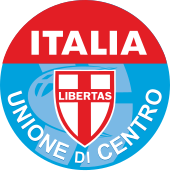
Back اتحاد المركز ARZ Unió dels Demòcrates Cristians i de Centre Catalan Unie středu Czech Unione di Centro German Ένωση Κέντρου (Ιταλία, 2002) Greek Unión de Centro (2002) Spanish Union de centre French Unione di Centro (2002) Italian 中道連合 (イタリア) Japanese Unio democraticorum Christianorum et medii democratici Latin
Union of the Centre Unione di Centro | |
|---|---|
 | |
| Abbreviation | UDC |
| Secretary | Lorenzo Cesa |
| President | Antonio De Poli |
| Founded | 6 December 2002 |
| Merger of | Christian Democratic Centre United Christian Democrats European Democracy |
| Headquarters | Via in Lucina 10, Rome |
| Youth wing | Giovani UDC |
| Membership (2016) | 50,000[1] |
| Ideology | Christian democracy[2][3][4] Social conservatism[4][5] |
| Political position | Centre[6][7][8][9] to centre-right[10][11] |
| National affiliation | Electoral list: Us Moderates (since 2022) Coalition: Centre-right coalition |
| European affiliation | European People's Party |
| International affiliation | Centrist Democrat International |
| European Parliament group | European People's Party |
| Colors | Light blue |
| Chamber of Deputies | 1 / 400 |
| Senate | 1 / 200 |
| European Parliament | 0 / 73 |
| Regional Councils | 10 / 896 |
| Website | |
| www | |
The Union of the Centre (Italian: Unione di Centro, UdC), whose complete name is "Union of Christian and Centre Democrats" (Unione dei Democratici Cristiani e Democratici di Centro, UDC),[12] is a Christian-democratic[2][3][4] political party in Italy.
Lorenzo Cesa is the party's current secretary, while Antonio De Poli its president. For years, Pier Ferdinando Casini was the most recognisable figure and de facto leader of the party, before eventually distancing from it in 2016. The UdC is a member of the European People's Party (EPP) and the Centrist Democrat International (CDI), of which Casini was president from 2004 to 2015.[13][14]
The party was formed as "Union of Christian and Centre Democrats" in December 2002 upon the merger of the Christian Democratic Centre (CCD), the United Christian Democrats (CDU) and European Democracy (DE). In 2008 the party was the driving force behind the "Union of the Centre" (UdC), an alliance comprising, among others, The Rose for Italy of Bruno Tabacci and Savino Pezzotta, the Populars of Ciriaco De Mita and the Liberal Clubs of Ferdinando Adornato. Since then, the party's official name was neglected in favour of the alliance's and, since most of the UdC member parties have joined the UDC too, the UDC and the UdC started to overlap almost completely to the point that they are now indistinguishable.
The CCD was an early ally of Silvio Berlusconi's Forza Italia in 1994 and was part of the centre-right Pole/House of Freedoms since its establishment. Consequently, the UDC was consistently part of the centre-right until 2006. Later, it was affiliated neither to the centre-right nor the centre-left at the national level. Despite this, the party continued to take part in several regional, provincial and municipal governments with the old and the new Forza Italia, while forming alliances also with the centre-left Democratic Party in some regions and cities. In the 2013 general election the UdC was part of With Monti for Italy, the coalition formed around Mario Monti's Civic Choice, and obtained a mere 1.8% of the vote, down from 5.6% in 2008 and 6.8% in 2006. In December 2014 the party, which sat in Enrico Letta's government and Matteo Renzi's government (2013–2016), formed Popular Area with Angelino Alfano's New Centre-Right. In December 2016 the UdC left the alliance, did not join Paolo Gentiloni's government and suffered the final split by Casini and his followers. The party has since returned into the centre-right coalition's fold and took part to the 2018 and 2022 general elections within centrist joint lists. More recently, the UdC distanced from Forza Italia and formed an alliance with Lega.
- ^ Iannaccone, di Stefano (31 May 2016). "Casini lascia l'Udc, non rinnova la tessera".
- ^ a b Maurizio Cotta; Luca Verzichelli (2007). Political Institutions in Italy. Oxford University Press. p. 40. ISBN 978-0-19-928470-2. Retrieved 16 July 2013.
- ^ a b Paolo Segatti (2013). "Italy's Majoritarian Experiment: continuities and discontinuities in Italian electoral behaviour between the First and Second republics". In Hideko Magara; Stefano Sacchi (eds.). The Politics of Structural Reforms: Social and Industrial Policy Change in Italy and Japan. Edward Elgar Publishing. p. 111. ISBN 978-0-85793-293-8.
- ^ a b c Nordsieck, Wolfram (2018). "Italy". Parties and Elections in Europe. Archived from the original on 27 March 2019. Retrieved 2 April 2019.
- ^ Piero Ignazi (2008). Partiti politici in Italia. Il Mulino, Bologna. p. 58.
- ^ Baldini, Gianfranco; Cento Bull, Anna (2009). Governing Fear. Berghahn Books. ISBN 9781845457839 – via google.it.
- ^ "Bookies see Prodi as next president". ANSA.it. 15 January 2015.
- ^ "From Vasto to Paris: The Uneasiness of – Pierluigi Bersani, secretary of the – Il Sole 24 ORE". ilsole24ore.com. Archived from the original on 17 February 2015.
- ^ "Mario Monti's Political Pragmatism Scores Points in Italy and Europe". Spiegel. Hamburg, Germany. 20 March 2012.
- ^ I cattolici oltre la politica. Il senso della testimonianza (in Italian). Effatà. 2010. ISBN 9788874024322.
- ^ Mark Donovan; Paolo Onofri (2008). Frustrated Aspirations for Change. Berghahn Books. pp. 70–80. ISBN 978-1-84545-638-2.
- ^ "PDF file" (PDF).
- ^ "Speaker details". www.eiseverywhere.com.
- ^ Andres Pastrana nuevo presidente de la internacional democrata centro, www.efe.com.
© MMXXIII Rich X Search. We shall prevail. All rights reserved. Rich X Search